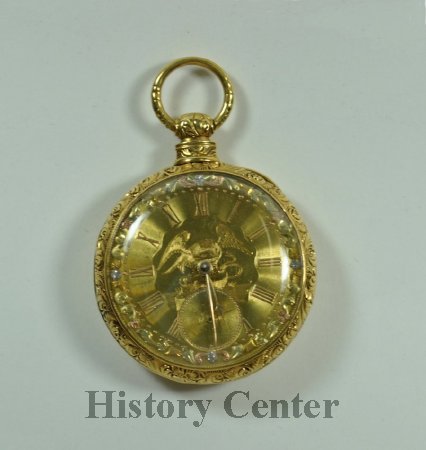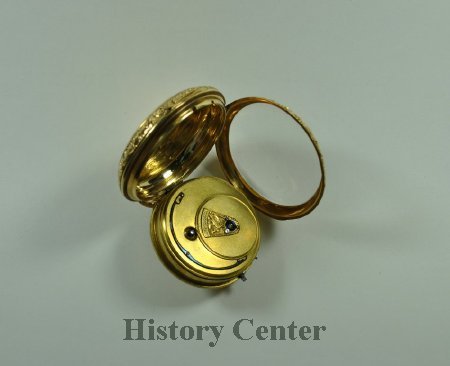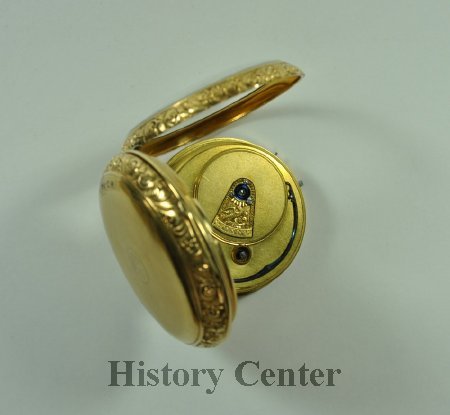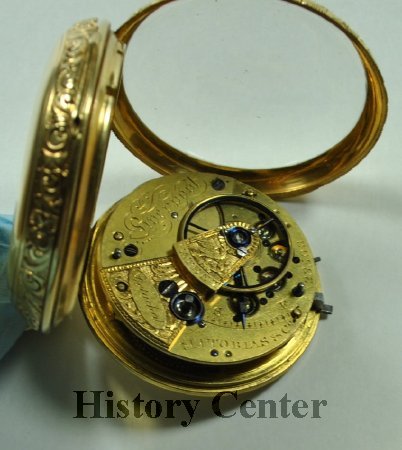Date:
1839
Title:
Godfroy Pocket Watch
Description:
James R. Godfroy (1810-1894)
Francis Godfroy (c. 1788-1840) was one of two major representatives of Miami interests in Indiana after the war of 1812 (second only to Jean Baptiste Richardville). By the 1830s, the earlier reliance on furs to purchase manufactured goods gave way to an Indian trade based on the wealth of the Miami nation acquired through several treaties up to 1841, a few years before most of the tribe was removed west. Francis and his trading partners near Peru, Indiana acquired considerable wealth in land and government specie payments during this period and were able to afford a fairly prosperous lifestyle. Merchants and traders sold goods to whites and Native Americans but their most lucrative profits came from more expensive goods purchased through a system of credit that was payable when the tribes received their annuity payments. Traders such Francis Comparet, Samuel Hanna, the Ewing Brothers and the Allen Hamilton & Cyrus Taber Company (1827-1840) trekked to New York where they obtained much of their stock and sold it in their trading houses in northeast Indiana for 100 percent or more above eastern market prices.
Among the list of goods Francis Godfroy purchased at Hamilton & Taber's store in Fort Wayne (they had another in Logansport) in May 1839 was a "gold watch for James," his son; it is engraved "JRG." It was expensive, $145 plus $2.50 for a watch key. The M. I. Tobias & Co. of London marketed watches to buyers in the United States and this one likely made its it journey from London to New York and then to Fort Wayne. James Godfrey grew up along the Wabash but after his marriage to Archangel (Montesquah), a granddaughter of Jean Baptiste Richardville, he lived in the old homestead on Bluffton Road near Fort Wayne. The watch was passed down to his son George-the Fort Wayne Morning Journal, 18 October 1895, mentioned it was on display in the "Art Room" during Fort Wayne's Centennial celebration: the "a gold watch which was carried by Chief Godfrey, and loaned by his son, Mr. George Godfrey…." The fine gold watch was given to William Geake, a close friend of George Godfroy in 1902. The family donated it the Historical Society in 1949.
Francis Godfroy (c. 1788-1840) was one of two major representatives of Miami interests in Indiana after the war of 1812 (second only to Jean Baptiste Richardville). By the 1830s, the earlier reliance on furs to purchase manufactured goods gave way to an Indian trade based on the wealth of the Miami nation acquired through several treaties up to 1841, a few years before most of the tribe was removed west. Francis and his trading partners near Peru, Indiana acquired considerable wealth in land and government specie payments during this period and were able to afford a fairly prosperous lifestyle. Merchants and traders sold goods to whites and Native Americans but their most lucrative profits came from more expensive goods purchased through a system of credit that was payable when the tribes received their annuity payments. Traders such Francis Comparet, Samuel Hanna, the Ewing Brothers and the Allen Hamilton & Cyrus Taber Company (1827-1840) trekked to New York where they obtained much of their stock and sold it in their trading houses in northeast Indiana for 100 percent or more above eastern market prices.
Among the list of goods Francis Godfroy purchased at Hamilton & Taber's store in Fort Wayne (they had another in Logansport) in May 1839 was a "gold watch for James," his son; it is engraved "JRG." It was expensive, $145 plus $2.50 for a watch key. The M. I. Tobias & Co. of London marketed watches to buyers in the United States and this one likely made its it journey from London to New York and then to Fort Wayne. James Godfrey grew up along the Wabash but after his marriage to Archangel (Montesquah), a granddaughter of Jean Baptiste Richardville, he lived in the old homestead on Bluffton Road near Fort Wayne. The watch was passed down to his son George-the Fort Wayne Morning Journal, 18 October 1895, mentioned it was on display in the "Art Room" during Fort Wayne's Centennial celebration: the "a gold watch which was carried by Chief Godfrey, and loaned by his son, Mr. George Godfrey…." The fine gold watch was given to William Geake, a close friend of George Godfroy in 1902. The family donated it the Historical Society in 1949.









